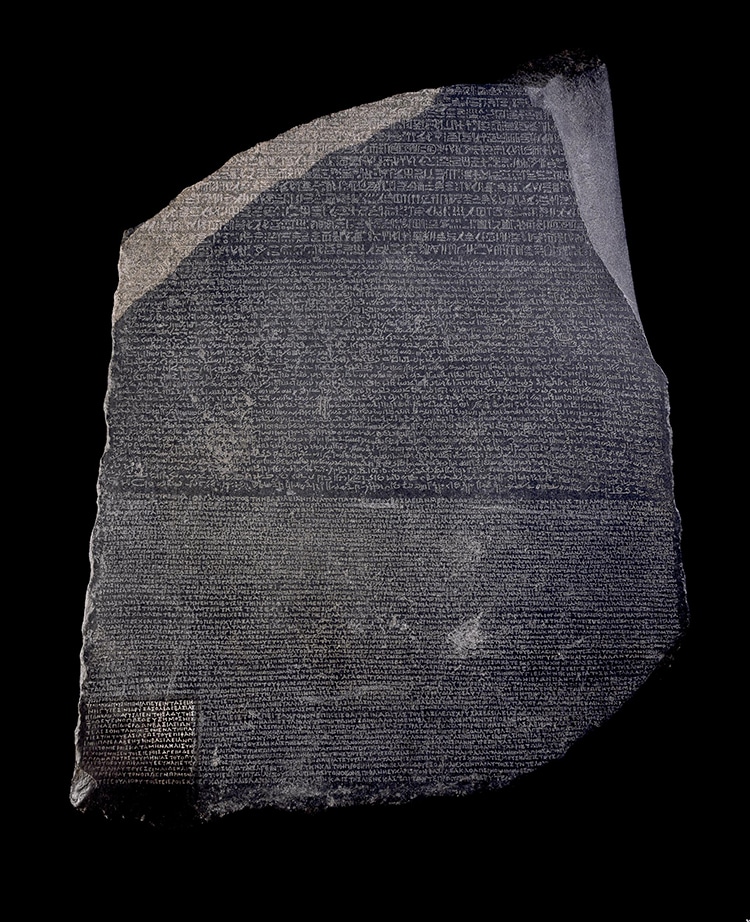Hieroglyphic Demotic and Greek a fact which immeasurably helped to. This black basalt stone slab was found in 1798 by French soldiers in the rubble of a wall near the Egyptian town of Rosetta.
 Everything You Ever Wanted To Know About The Rosetta Stone British Museum Blog
Everything You Ever Wanted To Know About The Rosetta Stone British Museum Blog
Standing just under four feet tall the stone weighs 1680 pounds.

Rosetta stone history. Where is it now. History uncovered in conserving the Rosetta Stone. Thanks to the discovery of the Rosetta Stone ancient Egyptian hieroglyphs could be deciphered unveiling secrets of the ancient civilization.
The Rosetta Stone is an ancient stele inscribed with the same passage of writing in two Egyptian language scripts and in classical Greek. An irregularly shaped stone of black granite 3 feet 9 inches 114 cm long and 2 feet 45 inches 72 cm wide and broken in antiquity it was found near the town of Rosetta Rashīd about 35 miles 56 km northeast of Alexandria. The Rosetta Stone is one of the most significant discoveries in the history of archaeology.
Allen Stoltzfus began studying Russian in the 1980s but became frustrated with his slow progress. He discovered that some hieroglyphs stood for a single sound - a part of a word. Founded in 1992 Rosetta Stone uses cloud-based solutions to help all types of learners read write and speak more than 30 languages including several endangered languages.
Only the date and the names were changed. It was created in 196 BCE discovered by the French in 1799 and translated in 1822 by the Frenchman Jean-François Champollion. The award-winning language solution combines proven learning methods with the worlds best speech recognition technology.
The person who found it was Pierre Francois-Xavier Bouchards a French officer of engineers. The Rosetta Stone is thus one of many mass-produced stelae designed to widely disseminate an agreement issued by a council of priests in 196 BC. This artifact was created during the Ptolemaic Period and was rediscovered at the end of the 18th century.
The Rosetta Stone is an incomplete grey and pink granodiorite stela dating from 196 BCE which presents a priestly decree concerning King Ptolemy V of Egypt. Called a stele or stela the Rosetta Stone was a type of public monument. History of the Rosetta Stone The Discovery In 1799 while digging in and building defensive positions near Rashid ancient Rosetta a small city outside Alexandria a soldier in Napoleons army discovered a black basalt stone 3 9 long by 2 4 wide with three distinct bands of engraving.
Ancient Egyptian coffin prepared for the Book of the Dead exhibition at the British Museum. Fortunately he knew there was a better way to learn a language through immersion which he had experienced years earlier while studying in Germany. It dates from 196 BCE and carries a decree written by priests in praise of the young pharaoh Ptolemy V.
The text is in three different versions. Rosetta Stone is the best way to learn a foreign language. In the middle there was shorthand demotic script and at the bottom was Greek reading left to right.
Rosetta Stone began with one mans quest for a better way to learn a language. Multilingualism along the Nile. The writing on it appeared very ancient at the top of the stone were hieroglyphs reading right to left.
Artifacts seized by Napoleon and his troops including obelisks and the Rosetta Stone made their way back to France where the Egyptologist Jean-Francois Champollion worked things out. In fact the text on the Stone is a copy of a prototype that was composed about a century earlier in the 3rd century BC. Other hieroglyphs stood for an idea - a whole bunch of words.
Discovery of the Rosetta Stone Discovered at Rosetta Raschid in 1799 by Napoleons army the Rosetta Stone proved the key to deciphering Egyptian hieroglyphs. Rosetta Stone Language Learning is proprietary computer-assisted language learning CALL software published by Rosetta Stone Inc. Rosetta Stone calls its approach Dynamic Immersion.
The artifact known as the Rosetta Stone is a thick slab of granodiorite rock. Decoding the Rosetta Stone. The software uses images text and sound to teach words and grammar by spaced repetition without translation.
It was sent to the Institut dEgypte in Cairo and then taken to London in 1802.
 The Rosetta Stone Article Ptolemaic Khan Academy
The Rosetta Stone Article Ptolemaic Khan Academy
 Rosetta Stone Definition Discovery History Languages Facts Britannica
Rosetta Stone Definition Discovery History Languages Facts Britannica
 What Is The Rosetta Stone And Why Was It Important Sporcle Blog
What Is The Rosetta Stone And Why Was It Important Sporcle Blog
 The Rosetta Stone Article Ptolemaic Khan Academy
The Rosetta Stone Article Ptolemaic Khan Academy
 The Rosetta Stone Article Ptolemaic Khan Academy
The Rosetta Stone Article Ptolemaic Khan Academy
 What Is The Rosetta Stone Learn About This Fascinating Ancient Artifact
What Is The Rosetta Stone Learn About This Fascinating Ancient Artifact
 What Is The Rosetta Stone History
What Is The Rosetta Stone History
 Egypt Calls On Uk To Return Rosetta Stone Egypt Independent
Egypt Calls On Uk To Return Rosetta Stone Egypt Independent
 Rosetta Stone Definition Discovery History Languages Facts Britannica
Rosetta Stone Definition Discovery History Languages Facts Britannica
 Newsela Rosetta Stone The Key To Cracking The Code Of Egyptian Hieroglyphics
Newsela Rosetta Stone The Key To Cracking The Code Of Egyptian Hieroglyphics




No comments:
Post a Comment
Note: Only a member of this blog may post a comment.